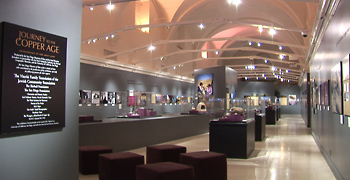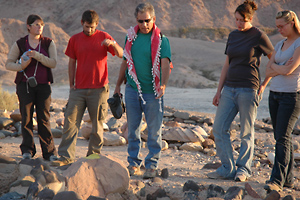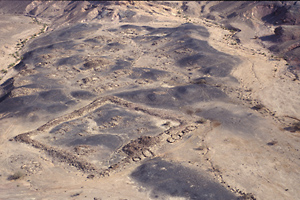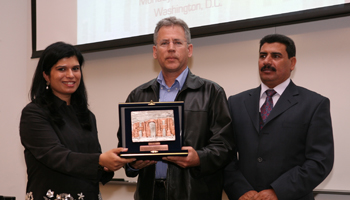Newsroom > Web Article
Journey to the Copper Age: Tracing the History of a Technological Revolution
San Diego, CA, June 19, 2007 -- San Diegans are getting a chance to travel back in time to the Middle East in pre-Biblical times, some 6,000 years ago. Their time machine is a new exhibition at the San Diego Museum of Man.
 |
Entrance to the "Journey to the Copper Age" exhibit at the San Diego Museum of Man, which opened June 10 and will run through next February.
To watch an excerpt from a 30-minute video produced by Calit2 for the exhibit, click here. [Real player and broadband connection required] Length: 4:21 |
|
“Journey to the Copper Age” opened to the public last week to rave reviews and it is guest-curated by UCSD archaeologist Tom Levy. The show features many of the relics uncovered by Levy on a series of digs over the past two decades in Israel and Jordan, as well as his ethno-archaeological research in India.
According to Levy, the exhibit traces the evolution of human society in the wake of fundamental technological change – notably the birth of metal technology and humans’ ability to transform matter.
“This exhibit and our academic research in India and the Middle East show us the powerful role of technological change in shaping societies,” says Levy. “I go back to the comparison with the information-technology revolution and its impact on us over the past 25 or 30 years: it’s the powerful transformation of our society, like what went on with the metal revolution.”
 |
| One of the most important pieces in the exhibit: mace head topped by a twin-headed ibex and swords, found in Israel's Cave of the Treasure in 1961. (Photo / The Israel Museum, Jerusalem) |
|
The wealth of artifacts on display at the Museum of Man includes some of the best-known objects found in a Judean cave called the Cave of the Treasure. Many are on loan from the Israel Museum. The 6,000-year-old maces, scepters and other ‘prestige’ objects – most being shown outside of Israel for the first time – indicate a relatively advanced civilization. But there was no evidence of where the objects had been made. In one of his earliest excavations in the 1970s, UCSD’s Levy found metal workshops in the Negev desert – just 80 miles away from the Cave of the Treasure.
More recently, Levy uncovered the largest ancient copper factory, dating back 3,000 years to the time of King David and other Biblical figures. Every summer the Department of Anthropology professor takes graduate and undergraduate students to the site in Jordan’s Faynan district, where they spend two months methodically – and painstakingly – excavating the ruins at Khirbat en-Nahas. The site remains visible via satellite, thanks to its blackened surface -- betraying thousands of tons of black metallurgical slag produced by the long-ago metal workshops.
 |
| UCSD professor Tom Levy (in green shirt) shows some of his students the remnants of 3,000-year-old metal slag at the Khirbat en-Nahas dig site in Faynan, southern Jordan. |
|
“In order to extract remaining droplets of metal still embedded in the slag after smelting operations, the metal workers intensively crushed slag waste using ground stone tools such as mortars, pestles, grinding slabs and anvils,” explains Levy, a professor of Anthropology and Judaic Studies. “Hundreds of these tools have been found in the excavations at the site by our UC San Diego team and Jordan’s Department of Antiquities, and many of the slag processing tools were found clustered near slag mounds.”
Levy is the inaugural holder of UCSD’s the Norma Kershaw Endowed Chair in the Archaeology of Ancient Israel and Neighboring Lands. Since 1997, his research has focused on the role of mining and metallurgy in early societies of southern Jordan. Says Levy: “I’ve tried to use metalworking as a lens to study social evolution.”
 |
| An aerial view of the largest ancient copper factory found to date; the dark spots left by years of metal deposits are even visible from space. |
|
The “Journey” of the exhibit is more than a metaphor. The show stems from a 1997 expedition funded by the National Geographic Society. Levy led researchers from four countries. They traveled on what is believed to have been an ancient metal trade route from southern Jordan into Israel. The trip took ten days because Levy and his colleagues chose to travel by donkey. Many of the stunning images of that trip, captured by National Geographic photographer Kenneth L. Garrett, are part of the exhibit and a companion book published by the Museum of Man.
While most of the exhibit features artifacts from the Middle East, “Journey to the Copper Age” also takes visitors to a small town in the south of India. In a half-hour documentary produced by the UCSD division of Calit2, Levy visits a workshop in Swamimalai where hereditary bronze casters – hereditary, because most can trace their family profession back 1,000 years -- use a technology that the UCSD expert believes may have been used by Copper Age artisans.
The “lost wax” method involves carving a wax model, then building a mold around it and heating it enough to dissolve the wax, which is drained out of the mold, before molten metal is then poured in. The video documents the process as the metal workers use the lost wax method to make a replica of a twin-headed ibex mace head discovered in 1961 in the Cave of the Treasure.
 |
| At the 10th International Conference on the History and Archaeology of Jordan held at George Washington University in Washington, D.C., in May, UCSD archaeologist Tom Levy received the Publication Award from the Department of Antiquities of Jordan for spearheading the publication Crossing Jordan: North American Contributions to the History and Archaeology of Jordan (London: Equinox). Two chapters of the book focus on efforts within Calit2 to develop a Digital Archaeological Atlas of the Holy Land. The award was presented by Her Royal Highness Princess Sumaya bint El Hassan, second daughter of Their Royal Highnesses Prince El Hassan bin Talal and Princess Sarvath El Hassan. HRH Princess Sumaya (left) presented the award with Dr. Fawwaz al-Khraysheh (right), Director General of the Department of Antiquities of Jordan. |
|
I think that in order to produce a large copper scepter, you would have to use the method we are investigating in Swamimalai,” says Levy. “So we can learn a great deal of how the Copper Age craftsmen produced their amazing works from copper by looking at how the craftsmen of Swamimalai produce theirs.” The documentary will air this summer on UCSD-TV, and Levy is talking with Calit2 about creating a video archive of traditional arts and crafts, many of which are disappearing in the face of newer, cheaper manufacturing methods.
The exhibition is settling in for a long run at the Museum of Man; it will be on display through next February. It is expected to draw a growing crowd of interested museum-goers this summer, thanks in part to another exhibition in Balboa Park, when some of the Dead Sea Scrolls go on display at the Natural History Museum. Levy notes the irony that the signature piece of “Journey to the Copper Age” was found at the Cave of the Treasure by archaelogists looking for the Dead Sea Scrolls. What they found instead was the treasure trove of 6,000-year-old copper objects, whereas the Dead Sea Scrolls date back barely 2,000 years.
Levy was in San Diego for the opening, but a few days later jumped on a plane. With wife and collaborator Alina, he is already headed back to Jordan for the summer dig season, and more than a dozen UC San Diego students will be joining them at the Jordanian site.
Related Links
Journey to the Copper Age
Thomas Levy Bio





